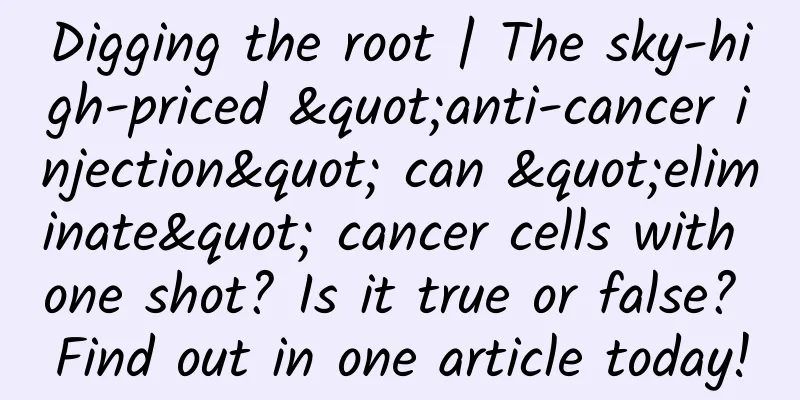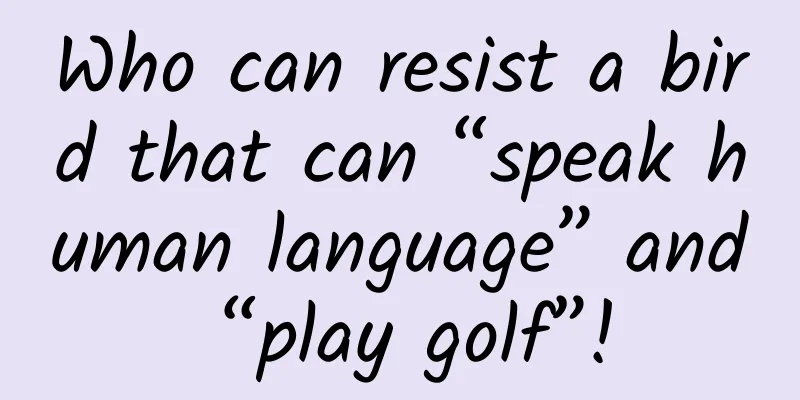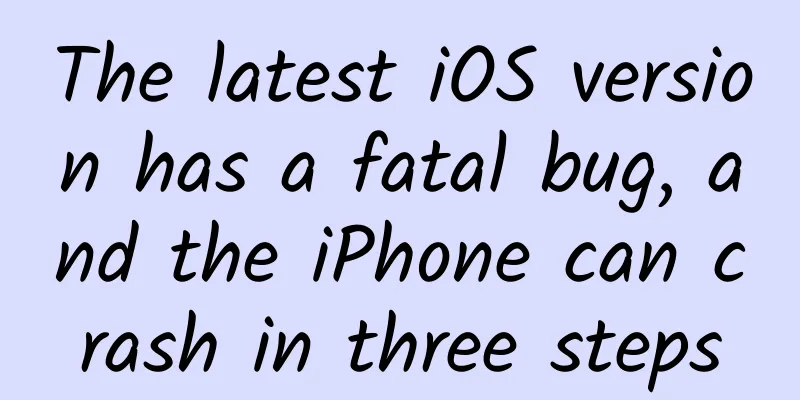Digging the root | The sky-high-priced "anti-cancer injection" can "eliminate" cancer cells with one shot? Is it true or false? Find out in one article today!

|
gossip In recent years, a kind of "anti-cancer injection" has suddenly become popular in the market. Some people believe that this "anti-cancer injection" can cure all cancers, while others misinterpret the word "anti" in anti-cancer injection and think that taking this injection can prevent cancer just like taking a vaccine. At the same time, the high cost of "anti-cancer injection" has also led to various scams. So, what exactly is the anti-cancer injection? Can the anti-cancer injection really cure all cancers? analyze It can be said that the above statements are all caused by misunderstandings about the "anti-cancer injection". The real anti-cancer injection is a new medical method called CAR-T therapy. In principle, CAR-T therapy helps us kill cancer cells by transforming our own T cells. Although CAR-T therapy is effective for some patients with blood tumors, it still has great limitations and room for growth, and is not yet a "magic drug" that can cure cancer. The diagram shows the process mechanism of the "anti-cancer injection" CAR-T. Image source: wiki The real identity of the “anti-cancer injection” is CAR-T therapy The widely publicized "anti-cancer injection" is actually called CAR-T. CAR-T is the acronym for Chimeric Antigen Receptor T-Cell Immunotherapy, which means chimeric antigen receptor T-cell immunotherapy in Chinese. This name seems to be confusing, but don't worry, we will explain it one by one. This therapy can be divided into three parts, namely Chimeric Antigen Receptor, T-Cell and Immunotherapy. Let’s look at it step by step from back to front. First of all, we can see that this is an immunotherapy. For cancer, traditional treatment strategies include radiotherapy, chemotherapy, surgery, etc. But you may also wonder, doesn't our human body have immunity? Usually, many diseases are dealt with by immunity. Since tumors are a disease, can't there be immunity against tumors? Immunotherapy uses this basic mechanism. However, the human body's immunity is very complex. There are both non-specific immunity and specific immunity. The latter is divided into humoral immunity and cellular immunity. So, in the response to tumors, which type of immunity is more worthy of attention? Thus, the second keyword appeared - T-Cell. T-cell is a type of human immune cell, which originates from the bone marrow but differentiates and matures in the thymus (the name of T-cell comes from the first letter of thymus). T-cell can exert immune function in immune organs and tissues throughout the body through lymphatic and blood circulation. In tumorigenesis, T cells play a key role. They can specifically recognize the antigens expressed by tumors and respond to them, thereby clearing the tumor. For example, CD8+T cells can directly kill tumor cells, while interferon gamma (IFN-γ) and tumor antigen-specific globulin (IgG) secreted by CD4+T cells can also clear tumors. T cells and tumors, source: [1] If this is the case, then why do we still get cancer? This has to do with a special ability of tumors: they have evolved through long-term adaptation to disguise themselves, which can blunt or even escape immunity. As a result, the body ignores the existence of the tumor, and cancer develops. Multiple factors affect the relationship between tumors and immunity. Image source: Wikipedia What to do? Can we modify T cells so that they can function again? This is the third keyword - Chimeric Antigen Receptor, which is the origin of the abbreviation CAR. This is a modification strategy. Through the gene modification strategy, CAR can fuse genetic materials such as specific antigen recognition domain, hinge region, transmembrane region, and co-stimulatory signal activation region with T cells, which is chimerism. The structure of CAR-T, source document [2] The T cells transformed in this way are called CAR-T. This new type of T cell will no longer be confused by the tumor and can directly target and kill tumor cells, so immunotherapy can be achieved. From this we can see that T cells are the main force in dealing with tumors, but tumors will disguise and passivate immunity to make T cells ineffective. Therefore, we transform T cells through a series of operations to allow T cells to function again and kill tumors. This is CAR-T therapy. CAR-T is not just a simple injection. It's a very complicated operation In fact, the operation of CAR-T is very complicated, including at least the following steps: 1 Therapeutic target detection CAR-T must first screen patients. Not all tumors are suitable for CAR-T. Currently, the CAR-T approved in my country is mainly for large B-cell lymphoma. Other tumors cannot be treated with CAR-T in my country. Different tumors also express different antigens, so tumor tissue testing and genetic testing are needed to determine the treatment target. 2 T cell collection Although there is currently a practice of using universal T cells, the patient's own T cells are generally selected. This step requires collecting blood from the patient, and then using special instruments and equipment to separate the cells in the blood. First, the immune cells are separated from the blood, and then the T cells are separated from the immune cells. 3 CAR-T cell preparation T cells are sent to the corresponding laboratory for special transformation, that is, adding CAR to T cells. This step is very demanding and needs to be operated in a GMP laboratory. Viral vectors such as lentivirus and retrovirus vectors are used to integrate CAR molecules into the genome of T cells to achieve stable expression. This process also requires quality control of CAR-T, such as random gene insertion problems and whether CAR-T can effectively amplify in vitro. 4 CAR-T cell reinfusion At this step, the CAR-T cell should be reinfused, but this step is still not easy. First of all, the patient needs to receive certain treatments, such as "lymph-clearing" chemotherapy, which mainly removes other lymphocytes, eliminates immunosuppressive factors, and provides conditions for CAR-T cells to function. The next step is to reinfuse the CAR-T, which is done by intravenous drip through a blood transfusion device or an infusion device. CAR-T operation steps, source NIH From this we can see that the operation of CAR-T is very complicated, requiring professional equipment and specialized medical staff and scientific researchers to work together. In addition, the entire process also requires CAR-T cell preparation and culture, which takes a long time. So, is CAR-T effective? At present, CAR-T has a significant effect in the field of hematological malignancies. Studies have shown that after using CAR-T, the complete remission rate of patients with B-cell acute lymphoblastic leukemia (B-ALL) reached 60%, the total remission rate reached 80%, and the 6-month relapse-free survival rate was 80%. CAR-T can exist in the body for a long time. Studies have shown that the median detection time of CAR-T cells in peripheral blood samples can be as long as 168 days. These data show the excellent therapeutic effect of CAR-T and make immunotherapy a practical strategy for dealing with tumors. At present, many countries have approved CAR-T therapy, and my country has also approved three CAR-T therapies, two for large B-cell lymphoma and one for multiple myeloma. However, can CAR-T really cure cancer? Is CAR-T really a panacea? The answer is no. There is still a lot of room for improvement in CAR-T First of all, like most medical treatments, CAR-T has side effects. CAR-T has obvious toxicity, including severe cytokine release syndrome (CRS) and immune effector associated neu-rotoxicity syndrome (ICANS). These are often related to immunity. For example, CRS is related to various cytokines such as IL-6 and IL-1. If these factors are unreasonably elevated, they will further trigger cytokine storms and bring serious effects to patients. Therefore, after CAR-T transfusion, patients need to be observed and adverse reactions need to be treated in a timely manner. In fact, toxic reactions during CAR-T treatment are very common. Many studies have pointed out that the incidence of CRS and neurotoxicity (NT) in CAR-T treatment is not low. Image source: [3] Secondly, CAR-T has a certain range of adaptability. In the previous article, when we introduced the principle of CAR-T, we pointed out that CAR-T uses T cells for immunity, and T cells often recognize tumors through receptors on the cell surface for elimination. Therefore, the range of tumors suitable for CAR-T treatment is limited to a certain extent. The currently approved CAR-T treatment scope includes acute B-cell acute lymphoblastic leukemia, B-cell lymphoma, follicular lymphoma, multiple myeloma and other tumors, all of which are blood tumors. Common cancers such as lung cancer, gastric cancer, liver cancer, pancreatic cancer, etc. are generally called solid tumors. Since these tumors rarely express a tumor-specific antigen, they will lead to additional toxicity of targeted tumor therapy. In addition, solid tumor tissues will form many barriers to prevent CAR-T cells from approaching tumors. In addition, the microenvironment of solid tumors will also affect CAR-T. These factors limit the application of CAR-T in solid tumors. In addition, CAR-T is not always able to cure cancer 100%. In fact, tumor recurrence is also a challenge faced by CAR-T treatment. According to statistics, the probability of recurrence in patients one year after receiving CAR-T treatment is as high as 30%-50%, which may be related to the exhaustion of CAR-T cells in the patient's body. However, improvements to CAR-T are ongoing. ▶ On the one hand, the scope of application of CAR-T therapy has been expanding in recent years. Traditional CAR-T is mainly applicable to blood and lymphatic system tumors, and has not yet been clinically approved for solid tumors. In addition, in recent years, however, relevant research on the treatment of solid tumors has been carried out, and it currently shows great therapeutic potential. The application potential of CAR-T is far more than that. Based on its immune characteristics, CAR-T is not only applicable to tumors, but also other diseases can be treated by CAR-T. For example, CAR-T for systemic lupus erythematosus has obtained implicit approval for clinical trials. ▶ On the other hand, the enhancement of CAR-T efficacy is also underway. In order to enhance the expansion and persistence of CAR-T cells and delay the exhaustion of T cells, researchers have been modifying CAR molecules to enhance their intracellular signal stimulation domains. The first generation of CAR molecules has a CD3ζ structure, which is the first signal for T cell activation, but the effect in vivo is not good. Therefore, the second generation of CAR added co-stimulatory molecules such as CD28 and ICOS on the basis of CD3ζ. The third generation of CAR further contains two co-stimulatory domains, which can play a role in multiple aspects from T cell metabolism, phenotype to downstream signal transduction. Today, CAR has developed to the fourth generation and has stronger anti-tumor immunity. History of the development of the fourth generation of CAR-T, source document [4] in conclusion We can see that the "anti-cancer injection" CAR-T is not omnipotent, but has a certain scope of application. Although it has shown good clinical effects in blood and lymphatic system tumors, it is still not 100% effective. Therefore, for cancer, chemotherapy, surgery, radiotherapy and other methods are still the mainstream strategies. Author: Li Lei, PhD in Biology, Chinese Academy of Sciences Reviewer: Liu Yao, Chief Physician of Hematological Oncology, Hematological Oncology Center, Affiliated Cancer Hospital of Chongqing University literature: [1]Waldman, Alex D., JillM. Fritz, and Michael J. Lenardo. "A guide to cancer immunotherapy: from T cell basic science to clinical practice." Nature Reviews Immunology 20, no. 11 (2020): 651-668. [2]Hughes-Parry, Hannah E., Ryan S. Cross, and Misty R. Jenkins. "The evolving protein engineering in the design of chimeric antigen receptor T cells." International Journal of Molecular Sciences 21, no. 1 (2019): 204. [3]Sermer, David, and Renier Brentjens. "CAR T-cell therapy: Full speed ahead." Hematological oncology 37 (2019): 95-100. [4]cartZhang, Cheng, Jun Liu, Jiang F. Zhong, and Xi Zhang. "Engineering car-t cells." Biomarker research 5, no. 1 (2017): 1-6. The article is produced by Science Refutes Rumors. Please indicate the source when reprinting. The cover image of this article comes from the copyright library. Reprinting and quoting it may cause copyright disputes. |
Recommend
There is a kind of cancer that is caused by burning
This is the 3666th article of Da Yi Xiao Hu Eatin...
Yahoo has been in business for 20 years. Is it time to enter the mobile Internet market?
Editor’s Note: Finding breakthroughs in the mobil...
Why is it so difficult to have children? Human evolution theory will give a reasonable answer
When we watch "Animal World", we often ...
Detailed explanation of how to increase traffic and followers on Xiaohongshu
How does Xiaohongshu increase followers and make ...
Bank of America Merrill Lynch: China remains a strong support for Apple's performance
Beijing time, January 13, "struggling" ...
What is the difference between WeChat Phonebook and VoLTE?
WeChat Phonebook is now online! How big of an imp...
APP Promotion Tips | Make good use of Weibo light application and you can use big tricks without spending any money!
Preface The concept of light applications was pro...
The cost of replacing batteries is as high as 1.6 trillion yuan. It is time to test China's first batch of electric car users.
Electric vehicles are the mainstream trend in Chi...
Google's three magic weapons to maintain its search dominance
On January 18, the American website medium.com pu...
Are stars necessarily heavier than planets? This "forbidden" planet breaks the stereotype!
This 'forbidden' exoplanet is too massive...
I can't get up for work and wake up too early on vacation. Why is this happening?
Not being able to get up for work and waking up t...
What are the functions of the Lanzhou WeChat restaurant ordering mini program? How much does the WeChat food ordering app cost per year?
With the continuous development of the Internet, ...
A collection of 10 classic cases of growth hacking, including To C and To B
Since Sean Ellis proposed the concept of Growth H...
Down jackets don't actually contain "down"? The police took action! One picture shows how to distinguish true from false
“No need for 998, no need for 198!” “Down jacket ...









